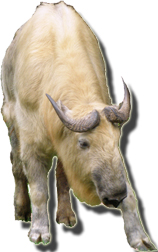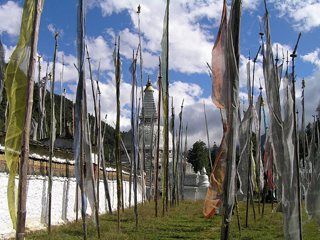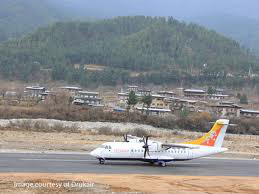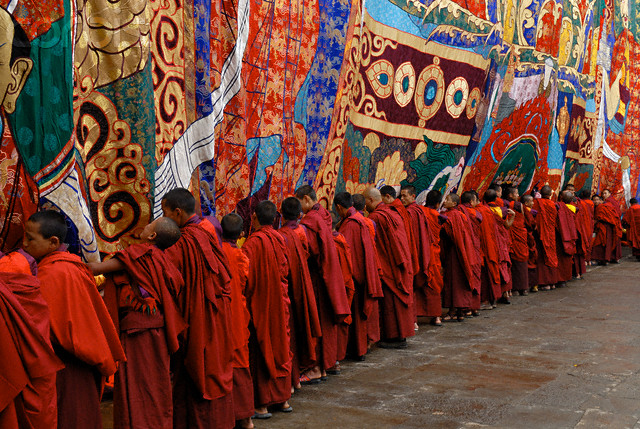
[ Thimphu Festival Tour | Thangbi Mani Festival Tour | Jambay Lhakhang Drup Tsechu Festival Tour | Black Crane Festival Phobjikha Tour | Punakha Domchey Festival Eight Nights Tour | Punakha Domchey Festival Ten Nights Tour | Chorten Kora Tsechu (arrive Paro, Depart Paro) | Chorten Kora Tsechu (arrive Paro, exit India) | Chorten Kora Tsechu (arrive India, exit Paro) | Gom Kora Tsechu (enter Paro, exit Paro) | Gom Kora Tsechu (enter Paro, exit India) | Gom Kora Tsechu (enter India, exit Paro) | Paro Tsechu Festival Tour | Paro Tsechu Festival 7 Dzongkhags Tour | Paro Tsechu Festival Tour with Druk Path Trek | Ura Yakchoe Festival Tour ]
Punakha Domchey Festival Ten Nights Tour
- Western & Central Bhutan
Dzongkhags covered: Paro, Thimphu, Wangdue, Trongsa, Bumthang, PunakhaDuration: 10 Nights 11 Days
Day to Day Outline Itinerary:
Day 1: Arrival Paro
Day 2: Paro Sightseeing & evening Thimphu
Day 3: Thimphu Sightseeing
Day 4: Thimphu to Gangtey/Phobjikha
Day 5: Phobjikha to Bumthang via Trongsa
Day 6: Bumthang Sightseeing
Day 7: Bumthang- Excursion to Ura
Day 8: Bumthang to Punakha
Day 9: Punakha Festival
Day 10: Punakha Festival & drive back to Paro
Day 11: Departure
Punakha Domchey:
This festival includes masked dances; with spectacular costumes made of yellow silk or rich brocade, often decorated with ornaments of carved bone. For certain dances, the monks wear masks which represent fearsome deities, animals or skulls of human beings. This festival takes place in the first month of the lunar year and ends with ‘Serda’, a magnificent procession which reenacts an episode of the war against the Tibetans in the 17th century.
Detailed Itinerary:
Day 1: Arrival Paro
The flight to Paro crosses the Himalayan Mountains, giving you spectacular views of the awesome peaks, including the sacred Jhomolhari and Jichu Drakey peaks in Bhutan. Upon arrival in Paro, you will be greeted by the Bhutan Rebirth representative and taken to your hotel. In the afternoon, you can visit the Paro Rinpung Dzong. It was built in 1646 and now houses government offices and religious institutions, as do all the Dzongs (fortresses) currently. You will cross a traditional wooden bridge on the way to the Dzong. You can then tour the Tag Dzong which is also the National Museum, formerly the watchtower for the Dzong. It now houses a collection of fine arts, paintings, thangkas, statues, and antiques. Afterwards you will visit Kyichu Lhakhang, the oldest temple in the country. In the evening you can stroll through the Paro market and town. Overnight in Paro.
Day 2: Paro Sightseeing & evening Thimphu
After breakfast hike to Taktsang (Tiger's Nest) Monastery, which is Bhutan's most famous monastery. Guru Rinpoche is said to have flown on the back of a tigress from Singye Dzong in Lhuentse to meditate in a cave where Taktsang Monastery now stands. It is perched on the edge of a steep cliff, about 900 metres above Paro Valley. The hike to reach the viewpoint to the monastery makes for a nice half-day excursion. After lunch, drive to Thimphu. In the evening you can explore Thimphu, the capital of Bhutan, and absorb the lifestyle of the people. You can also visit some interesting handicraft shops. Overnight in Thimphu.
 Day
3: Thimphu Sightseeing
Day
3: Thimphu Sightseeing
After breakfast you will visit the Memorial Chorten (built in memory of the third King of Bhutan who reigned from 1952-1972), Changangkha Monastery, the radio tower (for a bird's eye view of Thimphu Valley and the Thimphu Dzong), and the zoo, which contains the National Animal of Bhutan- the Takin (see left). From there you will visit the nunnery temple, the National Library (where ancient manuscripts are preserved), and the School of Arts and Crafts (also known as the painting school). After a relaxing lunch, you will visit the National Institute of Traditional Medicine, a traditional paper factory and Semtokha Dzong (the oldest fortress in the Kingdom). Also visit the majestic Tashichhodzong, ‘the Fortress of the Glorious Religion’ housing some Ministries, His Majesty’s Secretariat, and the Central Monk Body. Overnight in Thimphu.
Day 4: Thimphu to Gangtey/Phobjikha
We head out of town on a spectacular 5 hours drive to Phobjikha valley crossing the Dochula Pass at 3100 metres from where you can see the 108 beautiful Chortens built by Her Majesty the Queen Mother, Ashi Dorji Wangmo Wangchuck. From this pass on a clear day, you can have a superb view of the highest peaks in Bhutan. After a hot cup of tea at a cafe atop the pass and time to savour the mountain views, we continue our drive to Phobjikha Valley in Wangdue Dzongkhag.
We hike in the beautiful environment of the Phobjikha Valley and visit a farm house. It is a glacial valley on the western slopes of the Black Mountains. The only Nyingmapa (a sect of Buddhism) monastery, Gangtey goemba sits prominently on a hilltop. The valley is a designated conservation area and borders on the Black Mountain National Park. Because of the large flock of Black-Necked Cranes (Grus nigricollis) here that migrate for the winter from Tibet, it is one of the most important wildlife preserves in the country.
The Royal Society for the Protection of Nature (RSPN)’s Crane Observation Education Centre was established in Phobjikha Valley in 1996 by the Bhutanese government with assistance from the World Wildlife Fund. The Centre studies the conservation needs of the valley and holds workshops for farmers and students. Here you can use the Centre’s powerful binoculars to observe the cranes in the valley and also get information about the cranes. The rare and endangered black-necked crane occupies a special place in Bhutanese hearts and folklore. Its arrival every autumn from Tibet inspires songs and dances- it usually heralds the end of the harvesting season and signals to the villagers that the time has come to pack up and go to the warmer lower valleys since Phobjikha valley is snowed-in during the winter months. The world’s entire population of about 5000 Black-necked cranes breed in Tibet and Ladakh. They winter in south-central Tibet and Bhutan. Overnight at lodge.
Day 5: Phobjikha to Bumthang via Trongsa
 We
continue our drive to Trongsa crossing the Pelela pass (altitude 3,300
metres above sea level), the traditional boundary between east and west
Bhutan. The pass is marked by a large prayer flag and the ground is covered
with high altitude dwarf bamboos. Stop enroute at Chendbji Chorten
(right), which was built in the 18th century by a lama named
Shida- it is Nepalese in style with eyes painted at four cardinal points
(see left). After breakfast walk by Trongsa Dzong, built by Shabdrung
Ngawang Namgyal, the unifier of Bhutan, in 1647 and visit the Tag Dzong
(watch tower), dedicated to the Buddhist epic hero, King Gesar of Ling.
Then drive to Bumthang which is about a 2 hours drive. 29 kms from Trongsa
the road reaches the Yutong La pass (alt. 3,400 m). Further 13 kms ahead
the road enters into a wide, open, cultivated valley known as Chumey valley.
On arrival in Bumthang, check into the lodge.
We
continue our drive to Trongsa crossing the Pelela pass (altitude 3,300
metres above sea level), the traditional boundary between east and west
Bhutan. The pass is marked by a large prayer flag and the ground is covered
with high altitude dwarf bamboos. Stop enroute at Chendbji Chorten
(right), which was built in the 18th century by a lama named
Shida- it is Nepalese in style with eyes painted at four cardinal points
(see left). After breakfast walk by Trongsa Dzong, built by Shabdrung
Ngawang Namgyal, the unifier of Bhutan, in 1647 and visit the Tag Dzong
(watch tower), dedicated to the Buddhist epic hero, King Gesar of Ling.
Then drive to Bumthang which is about a 2 hours drive. 29 kms from Trongsa
the road reaches the Yutong La pass (alt. 3,400 m). Further 13 kms ahead
the road enters into a wide, open, cultivated valley known as Chumey valley.
On arrival in Bumthang, check into the lodge.
Day 6: Bumthang Sightseeing
Bumthang valley is one of the most sacred in the Kingdom and innumerable legends surround the area. It is here that the Kings are cremated and the present Royal Family traces their ancestry back to the famous saint, Pemalingpa. Full day sightseeing include visit to Kurjey Lhakhang (where the Saint Padmasambhava subdued a local demon and left his body imprint on a rock), Jambay Lhakhang which was built in the 7th century, then Jakar Dzong (the Fortress of the White Bird) built in the 17th century by Tenzin Rabgay (the fourth Desi), Tamshing Lhakhang built in 1501 by Terton Pema Lingpa (the Founder of Religious Treasures). Then visit Kenchosum Lhakhang and Membartsho (the Burning Lake)- in fact it is a gorge where the river runs through but legend runs that Pema Lingpa discovered religious texts in this lake. Also worth seeing are the woodcraft workshop, traditional hospital, and the cheese factory. Overnight in Bumthang.
Day 7: Bumthang- Excursion to Ura
In the morning, we will hike to the Tamshing Goemba built in 1501 by the Buddhist Saint Pema Lingpa. Vsit Ura, 50 km from Bumthang. Ura is a beautiful village set amidst a pristine highland meadow across the Thumsingla Pass. The village has retained its traditional character and holds its own festival (Ura Yakchoe) that offers an insight into lives of the rural Bhutanese. The steepness of the region lends itself to some spectacular views, with rushing waterfalls and sheer drops. The drive on this route is exhilarating crossing Thrumshing La when you will see spectacular views of the Himalayan range on a clear day. Return and stroll around Bumthang. Overnight Bumthang.
 Day
8: Bumthang to Punakha
Day
8: Bumthang to Punakha
In the morning visit Batpalathang (battlefield where many Tibetans were believed to be massacred when they attacked Bhutan). This is also where the new domestic airport (at right) is located. Afterwards drive to Punakha, stopping for lunch along the way. Overnight at your hotel in Punakha.
Day 9: Punakha Festival

Monks at Punakha Tsechu unrolling the huge thangka or thongdrel
representing the Shabdrung, Unifier of Bhutan.
The annual Punakha Tsechu festival is celebrated in the impressive Punakha Dzong. Punakha is the former capital of Bhutan. The three day festival of Punakha is followed by Punakha Dromchoe Festival. This festival is dedicated to Yeshe Gompo (Mahakala) or Palden Lhamo, the two main protective deities of Drukpas (Drukpas = means people of Druk (Bhutan) or Bhutanese). Punakha Dromche take place in the first month of the lunar year and ends with ’Serda’, a magnificent procession which reenacts an episode of the war against the Tibetans in the 17th century. People from neighbouring village flock into the Dzong to attend the colourful festival. The Punakha Tshechu, as all Tshechu festivals, marks the heroic deeds of Guru Padmasambhawa, also known as Guru Rinpoche, the Precious Saint who introduced Tantric Buddhism throughout the Himalayas. Monks and laymen dressed in colourful brocade attire and wearing ferocious masks perform the tantric dances with chants from Buddhist scripts. The culmination of the festival constitutes the unfolding of a huge cloth thangka, a sacred scroll, depicting Padmasamabhava (Guru Rinpoche) and imagery from Buddhist Pantheon.
Day 10: Punakha Festival & drive back to Paro
Morning attend some festivities and drive to Paro via Dochula. After a hot cup of coffee at a cafe atop Dochula Pass, we continue our drive to Paro. Visit Tag Dzong built in the 17th century as a watch tower for Paro Dzong (Rinpung Dzong). This Dzong was later converted into the National Museum in 1967, and is filled with antique thangkhas, paintings, textiles, weapons and armour. Also visit the Rinpung Dzong, built in the 17th century to defend the valley against Tibetan invaders. It is now used as an administrative centre and home of the monastic community. Kyichu Lhakhang, the oldest monastery in the Kingdom is another place of interest. Overnight at Hotel in Paro.
Day 11: Departure
Say Goodbye and Farewell from Paro Airport. Hope to see you again!!
| |
BACK TO FESTIVAL TOURS MAIN PAGE |
